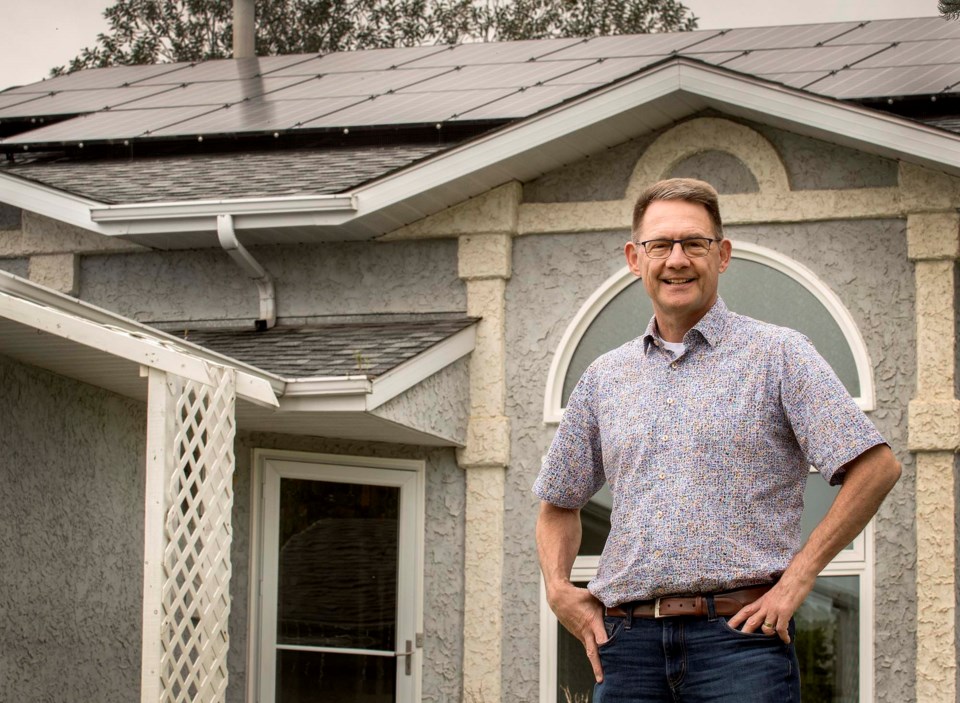Five years ago, St. Albert’s Ron Kube was concerned about carbon. He knew that heat and electricity was one of the top sources of heat-trapping pollution in Alberta (coming in second behind oil and gas extraction), and thought going solar might be the best way to do his part for the planet.
That’s when he read in the Gazette about how fellow resident Craig Dickey had one of the most productive rooftop arrays in Alberta.
“He used to live across the street from me,” Kube said, so he called him up and checked the system out.
Two years later, Kube built a $22,000 solar array on his roof to energize his home and an electric car. It now saves him about $3,600 a year on gasoline alone, and he guesses it will pay for itself in about five years.
“It’s kind of the way of the future if you’re concerned about the environment and want to do something,” he said of solar.
“It’s pretty easy to do.”
The rising sun
Solar power is on the rise in Alberta, with some 3,410 grid-tied systems now active in the province, according to the Solar Energy Society of Alberta’s solar generation odometer.
Most of Alberta’s electricity comes from carbon-heavy coal, said Dave Kelly, CEO of SkyFire Energy and an 18-year veteran of the solar industry. Put up solar panels, and you can tap the sun for power for a fraction of the cost and pollution of regular electricity.
Kelly said solar costs have plummeted in recent years to about $3 per watt installed, or about a tenth of what they were when he put an array up on his roof 18 years ago. Most homes can get by with a 2 to 10 kW system, which would cost $6,000 to $30,000 and pay for itself in less than 15 years.
“It’s better than money in a bank account,” he said.
While retrofits are common, Kelly noted that Jayman BUILT now includes solar by default in its new homes with his company's help, and that California requires solar on all new homes.
Dave Pearson went solar in 2015 by putting what is one of the biggest household arrays in St. Albert on his roof. To him, going solar was a way to be environmentally responsible and save money.
“I don’t pay electricity bills,” he said, and he’ll likely have earned back the cost of his system by next year.
Today’s prices make going solar a no-brainer, said Pearson, who works for CDN Power Pac (a company that specializes in renewable energy), especially since many installers let you cover your loan payments with the money you save from solar energy.
“You have to have the ability to pay your utility bill in order to afford solar.”
Do your homework
The first thing to do before you go solar is to rein in your energy use, said Kube. The less you use up front, the less you have to spend on solar panels.
“It doesn’t really cost you anything to unplug the old beer fridge in the basement,” Kube said, and in his case said fridge accounted for about 10 per cent of his power bill.
By switching to LED lights, using power bars and efficient appliances, and shutting off stuff when it wasn’t needed, Kube said he and his family slashed their annual power use to about 5,200 kWh from 12,000 kWh. He suggests using a watt meter (such as the ones included in the St. Albert Public Library’s HEAT Kits) to find the big energy hogs in your home.
Kube and Kelly said to hire a licenced electrician to design and install your system, as there's a lot of permits and engineering involved. The Solar Energy Society has a list of qualified installers.
Data from the NAIT Reference Array in Edmonton suggests that Edmonton-area solar panels should be set at 53 degrees for optimum production. Kelly said a south-facing roof is best for this hemisphere, but anything but north works. If you’ve got 20-year-old shingles, you should replace those before you put panels on top of them, as it’s expensive to take them off to re-shingle.
Most solar systems feed power into the grid and don’t have batteries, Kelly said. If you want batteries (e.g. to live off-grid or have power in a blackout), expect to pay a lot of money.
Pearson and Kelly said most solar systems come with 12- to-25-year warranties and last 30 to 40 years. They require very little maintenance apart from checking the inverters every so often – you don’t have to wash them, and it’s not worth clearing snow off them (the panels don’t produce much in the winter anyway).
Solaralberta.ca has more on how to get started with solar.




